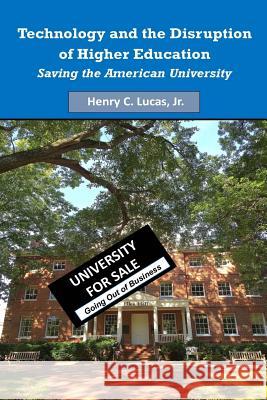Technology and the Disruption of Higher Education: Saving the American University (Color Version) » książka
Technology and the Disruption of Higher Education: Saving the American University (Color Version)
ISBN-13: 9781508803706 / Angielski / Miękka / 2015 / 250 str.
Technology and the Disruption of Higher Education: Saving the American University (Color Version)
ISBN-13: 9781508803706 / Angielski / Miękka / 2015 / 250 str.
(netto: 190,38 VAT: 5%)
Najniższa cena z 30 dni: 200,46
ok. 16-18 dni roboczych
Bez gwarancji dostawy przed świętami
Darmowa dostawa!
Review from the Midwest Book Review Critique: An exceptionally well researched, impressively written, accessibly organized and presented study, "Technology and the Disruption of Higher Education: Saving the American University" by Henry C. Lucas Jr., (Robert H. Smith Professor of Information Systems and Chair of the Department of Decision, Operations and Information Technologies, University of Maryland) is an seminal work of impressive and painstaking scholarship. An invaluable contribution to our national dialogue with respect to college and university educational missions in a digital age, "Technology and the Disruption of Higher Education" is very highly recommended for personal, professional, governmental, and academic library Higher Education reference collections and supplemental studies reading lists. Synopsis: American universities for years have been the bright spot in our educational system. Today, these institutions are under siege from multiple constituencies including students, parents, legislators, government officials and their own faculties. Education has historically been a way for students to improve their lives and fortunes. However, the rising costs of college are a barrier to access for many students, reducing their chances for upward mobility. Is technology the solution, or is it just another costly problem for universities? The purpose of "Technology and the Disruption of Higher Education: Saving the American University" is to explore how new technology has the potential to transform American higher education. However, this same technology also has the potential to disrupt universities. Much depends on how administrators, faculty and students apply technologically-enhanced learning. "Technology and the Disruption of Higher Education" presents details on MOOCs, blended, flipped and online classes and their role in transforming higher-ed based on my experiences teaching all of these types of courses. A blended course includes asynchronous material, usually on the Internet, that students access at their convenience. Faculty may post videos and other exercises they find on the Web, and they may create their own short video lectures. Class time is devoted to "active" learning, where students make presentations, solve problems, and discuss the issues in the course. A major contribution of this approach is to move from passive lecturing to an active learning environment. Fully online classes have existed for years, but technology available today makes it possible to have an online experience that includes synchronous interaction between faculty and staff online through video conferencing. "Technology and the Disruption of Higher Education" describes the development and contents of a high-quality, online MBA program that is very successful two years after it began. Massive Open Online Courses or "MOOCs" are the utility infielder of new educational technologies. They can be used in many different ways, as standalone courses for general interest or a certificate, as a supplement to college courses, or as the basis for a degree or even a new type of university. These technology-enabled approaches to teaching and learning offer tremendous opportunities to schools, but they also threaten the traditional university. "Technology and the Disruption of Higher Education" identifies some of these threats and opportunities and offers suggested strategies to take advantage of the technology. Is this technology enough to save the American University system? While new ways of teaching and learning are exciting, they are only part of the puzzle. Radical change beyond what happens in the classroom is needed if our higher education system is to continue to flourish and some of these ideas are discussed in the final chapter.
Zawartość książki może nie spełniać oczekiwań – reklamacje nie obejmują treści, która mogła nie być redakcyjnie ani merytorycznie opracowana.











